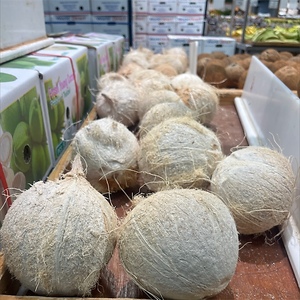


White Coconuts
Estimated Inventory, 20 ct : 0
This item was last sold on : 06/05/25
Description/Taste
White coconuts are round to oval-shaped fruits that average around 680 grams each. They are pointed at one end and encased in a fibrous off-white husk. Inside this husk lies a brown shell that surrounds the white coconut meat, or flesh, of the fruit. This firm flesh is bright white with a considerably more moist and fresh texture than the meat of Brown husked coconuts. It's usually about 1 to 2.5 centimeters thick and surrounds a hollow kernel filled with a sweet milk-like liquid. White coconuts have a rich, nutty flavor with a strong floral aroma.
Seasons/Availability
White coconuts are available year-round.
Current Facts
White coconuts are botanically known as Cocos nucifera and belong to the Arecaceae family, which encompasses all varieties of palms. White coconuts come from the same palms as Brown coconuts but are harvested before the fruit is fully mature, which is why they’re often referred to as Young coconuts. This variety is also called the Easy Break coconut because its shell is less developed and thus has a softer texture. In many tropical and subtropical parts of the world, the coconut is an important source of food. These fruits supposedly got their name from Spanish and Portuguese explorers who thought the three characteristic eyes on their shell looked like a goblin's grinning face and named it coco, the word for goblin. Coconut palm trees are the most widely cultivated species within the Arecaceae family and are valued for their culinary uses, providing meat, oil, and milk.
Nutritional Value
The nutritional value of White coconuts isn’t widely known, but the coconut species in general is a significant source of manganese, an essential mineral that supports bone health, cognitive function, and the respiratory system. Coconuts are rich in lauric acid, known for its antibacterial properties and immune-enhancing effects. The fiber found in coconuts aids digestion, helps reduce LDL cholesterol and triglyceride levels, and supports healthy blood sugar control. Coconuts are also packed with powerful antioxidants, including caffeic acid, salicylic acid, and gallic acid, which help neutralize free radicals and protect cells from oxidative damage. The presence of medium-chain triglycerides, or MCTs, provides a quick source of energy, while the conversion of MCTs into ketone bodies can benefit brain health and potentially assist in cognitive improvement for individuals with neurodegenerative conditions.
Applications
White coconuts are primarily used for their meat and the water within the fruit. To prepare them, drill two holes into the eyes of the rounder end of the coconut and drain the liquid. The milky-colored water can then be drunk directly from the fruit with a straw or drained by setting it in a bowl and letting the water drip out. The shell of the coconut can be opened by heating it at 190 degrees Celcius until it begins to crack. The fruit should then be briefly cooled and stricken with a hammer along the crack in order to pry out the flesh with a knife. The water from White coconuts can be integrated into smoothies, creamy iced teas, and rum-based drinks or poured on top of fruit salads to enhance their flavors. It can also be incorporated into Thai soups and curries with vegetables like bamboo shoots, carrots, potatoes, lemongrass, roasted chicken, ginger, and green onions. This liquid is used in desserts like coconut bread, pie, cake, pudding, custard, and Rice Krispie treats. The fresh meat from White coconuts is often grated to create coconut crust for pies, cookies, and macarons. It’s also mixed into granola, yogurt parfaits, stir-fries, salads, spring rolls, and breading for fried chicken, fish, shrimp, and vegetables. This meat is manipulated to create products like coconut milk, flour, and oil. White coconuts pair well with complementary ingredients like avocados, bananas, mangoes, papayas, dragon fruit, melons, strawberries, blueberries, raspberries, oranges, Jasmine rice, chia seeds, pecans, vanilla frosting, cream cheese, matcha, turmeric, curry powder, and tamarind. White coconuts will keep at room temperature for a week or two. For longer storage, they should be refrigerated.
Ethnic/Cultural Info
Coconuts are called Narikela or Sriphala in Sanskrit and are known as God’s fruit. In India, they have been incorporated into religious ceremonies, rituals, and used as gifts during festivals and marriages since ancient. In wedding traditions, the coconut is placed in a pot to symbolize the womb, while the nut represents life and fertility for the wedded couple. The bride is cautioned not to break the coconut, as it is treated like a symbolic fetus. She grants the coconut to her new husband and he is expected to keep it safe throughout his life. In the Kunbis of Maharashtra’s Konkan region of India, coconuts are kept as a memory of their ancestors’ lives.
Geography/History
White coconuts are native to Southeast Asia and are commonly found in Malaysia, Indonesia, the Philippines, and other regions of the Pacific Islands. They grow in tropical and subtropical climates. White coconuts can be foraged in the wild, but this is uncommon as they must be harvested at a specific stage to obtain their tender flesh. Coconuts began spreading worldwide when Arab traders brought them from India to East Africa about two centuries ago. They were then introduced to Europe through the Silk Road and by the 16th century, colonialism brought them to the Americas where they were particularly prolific in the Caribbean. White coconuts are frequently grown in the Dominican Republic, Mexico, India, and Southeast Asia. While less popular than their brown counterpart, White coconuts may be commonly found in Mexican and Asian supermarkets. They may also be cultivated in tropical gardens.
Recipe Ideas
Recipes that include White Coconuts. One
| Food Lovers |
|
Moist Feijoas and Coconut Cake |
| The Kitchn |
|
Coconut and Thai Basil Ice Cream |
| Just as Delish |
|
Beef Rendang Malaysian style |

















